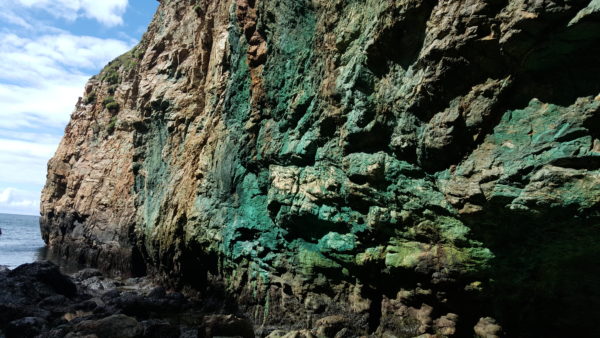Duneen mine is located on the Atlantic seaboard some 1.3 kilometres (0.75 miles) northwest of Allihies village. Mining began here in 1812. The exposed Duneen lode is a 23 metres high and 9 metres wide quartz vein which forms a narrow promontory extending some 83 metres into the ocean. The narrow path along the top is not for those of nervous disposition. Bright malachite stains the promontory walls, and a couple of adits are visible on the pebble beach at the foot of its north face. Inland, the promontory vein (east-west vein) passes through a “Z” bend (a short north-south vein) into the southeast vein. The lower courses of a pumping engine, a chimney stack and stamping engine remain on the east side of the road, with part of the cobbled ore dressing floor. Broken, mineralized quartz lies between the road and the cliff.

A BRIEF HISTORY
| 1812 | Mining in Allihies starts at Duneen. Adits driven into the lode from the beach but they were below the high water mark and led to flooding at Spring tides. | |
| 1818 | The mine already deemed hopeless! | |
| 1820 | A few tons of ore produced, opening the prospect of new trials. | |
| 1821 | (January, April) Two shafts sunk. (November) All work abandoned due to flooding. | |
| 1822 | (August) Decision to buy a steam engine from Harvey of Hale, Cornwall, for £894. (September) Engine shaft and engine house foundations begun. |
|
| 1823 | (June) Engine house complete. (September) Engine arrives by sea; 3 months to erect. | |
| 1825 | (April) Mine covering its expenses but without profit. | |
| 1826 | Still high hopes. (September) Only 21 tons of ore produced – not enough to maintain a steam engine. | |
| 1827 | Still hopeful. | |
| 1828 | Puxley’s optimism running out. | |
| 1829 | (February) Puxley considers closing mine, but (August) mining continues. Considers moving steam engine to Caminches mine but not suitable and corroded by salt water. | |
| 1830 | No improvement but reluctance to abandon mine. | |
| 1832 | (April) Steam engine restarted after repairs (corrosion from salt water) but only a trickle of ore results. | |
| 1834 | New powder house and workshop built – mine improving. | |
| 1836 | (June) To be abandoned due to failing ore… but continues for 2 years more! | |
| 1838 | (March) Mine abandoned. Cornish mine captain, Mark Reed, dismissed with pay to year’s end (returns to Cornwall and a career in mine management). | |
| 1868 | Henry Puxley sells the mines; new Berehaven Mining Company reopens the mine (1870). | |
| 1872 | New 22″ steam engine installed but little ore (processed at Kealogue mine) is produced. | |
| 1875 | Development continues (and into 1876). 1878 Mine finally abandoned. |

